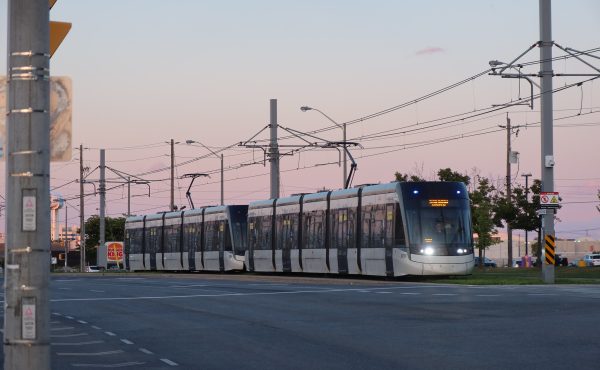 The University of Toronto’s new, very simple Varsity Stadium at Bloor W. and Bedford has been criticized for not contributing to this rapidly developing stretch of Bloor by adding retail, residents or interesting architecture. To me, however, its simplicity is actually a good balance — it opens up a stretch of the street just as other parts are being enclosed in by a series of new buildings — the ROM and Royal Conservatory extensions, the new University of Toronto residence at St. George, tall condos on the north side. As these parts get filled in, the formerly hulking Varsity Stadium has been removed and replaced with hardly a structure at all, just a mostly open perimeter, revealing a lovely space, letting in light and a view of downtown. The University could have closed it off to prevent people from seeing what’s happening in the field, but instead they have made the space very transparent.
The University of Toronto’s new, very simple Varsity Stadium at Bloor W. and Bedford has been criticized for not contributing to this rapidly developing stretch of Bloor by adding retail, residents or interesting architecture. To me, however, its simplicity is actually a good balance — it opens up a stretch of the street just as other parts are being enclosed in by a series of new buildings — the ROM and Royal Conservatory extensions, the new University of Toronto residence at St. George, tall condos on the north side. As these parts get filled in, the formerly hulking Varsity Stadium has been removed and replaced with hardly a structure at all, just a mostly open perimeter, revealing a lovely space, letting in light and a view of downtown. The University could have closed it off to prevent people from seeing what’s happening in the field, but instead they have made the space very transparent.
It helps that the new little plaza at the corner of Bloor and Devonshire has been nicely designed, to create a good new public space at a busy corner. I expect it will become a common meeting place — it is pleasant, there is seating and views to look at, and it’s at a cross-roads of destinations. I’ve seen quite a few people sitting there on pleasant fall days. This is a good example of the kind of placemaking the City needs to encourage systematically across Toronto.
One feature I particularly noticed is how they have covered the tree pits. They used simple metal grates, which let the water in but keep passersby from compacting the soil. I confess I’m at a loss as to why we don’t use these everywhere in the city – maybe they’re more expensive than concrete, but they last well and probably save the cost of replacing the tree as often. Someone suggested to me that there’s a concern that the metal will get stolen, but I think that it could be secured in concrete pretty easily — I haven’t heard of tree grates being stolen in other cities.
A city staffer once told me that the reason was that weeds grow through the grates — a process you can see in the picture below, and they were even larger earlier in the summer before they were cut back — and that as soon as weeds appear, the city gets lots of complaints from people because they think it looks unkempt. This attitude leaves me at a loss — to me, it’s great to see healthy green plants growing in these spaces — that should be an advantage, not a problem, and there’s no need to even cut them back. Maybe a solution instead is to seed the spaces around the tree with attractive native grasses and wildflowers, so that they look pretty and purposeful, but still take care of themselves without needing extra care.





10 comments
Aren’t there some sort of stones which prevent weeds (people spread them under decks). If these work they could be lightly laid under the grate to prevent weed growth while permitting water inflow, possibly with some gypsum added to reduce salt levels.
I’ve specified and installed hundreds of tree grates in new urban areas along the NJ waterfront. We actually use decorative ones that are quite a bit nicer than the galvanized metal shown in the Toronto photo. Mulch is used to keep the weeds down, but we’ve never had a problem. The design we use is similar to the KIVA on this page: http://www.urbanaccessories.com/treegrates1.htm
I noticed in Montreal that they use similar grates, except they use a radial pattern, rather than a grid. It looks like they cut off the inner ring when the trunk of the tree is getting close to filling the opening, so the tree has room to grow.
My only gripe with the new Varsity Centre is the giant brick wall along Bloor Street. I know it is a historical remnant of the old stadium, but it just kills the street.
“Someone suggested to me that there’s a concern that the metal will get stolen, but I think that it could be secured in concrete pretty easily  I haven’t heard of tree grates being stolen in other cities.”
Exactly. This is very often the case in planning, designing and implementing infrastructure in Toronto. Too often the city either neglects to follow or stubbornly ‘earmuffs’ itself against tried, tested and true methods from other cities around the world.
I love the idea of seeding the area with native grasses or wild flowers. That would create wonderful mounds of greenery breaking up the streetscape …of course the dark side is that once these mounds are full and the flowers are blossoming it will result in an excellent place to hide trash, unless there is a ravine around. Everybody knows ravines are the best place to throw trash. I live in the area of the india bazaar and visitors of the area look at the tree pits and planter boxes as just another trash can….how do we change that “I don’t care, its not my yard” mentality.
I sure wouldn’t mind seeing some of those other fancy tree grates from the above mentioned website…they are quite nice..
Re: Stolen tree grates. You wouldn’t embed the grate in concrete, only the frame. If you want to maintain the irrigation (if any), clean out the tree pit, or maintain the tree zone in any way, you’ll need to remove the grate. The best you can do is have some sort of keyed locking system.
The weight of grates is often a deterrent to theft, but I’ve had on my projects in other cities numerous tree grates salvaged for scrap. I’ve had street lights stolen too!
When metal prices go up, scavengers hit the road. Its too easy to just blame the City for not being open minded on this issue. Street furnishings are not cheap. Nickel prices are soaring and stainless steel is through the roof.
Ah, good point about the grates needing to be removable. But I hope there’s some way to make them effectively theft-proof, they are such a good idea.
I agree with Mark about the remaining brick wall – it has an unfortunate effect on the street, I too was hoping it would go completely – but at least it takes up less space than it used to.
This should be a park for the daily use of Torontonians, not a stadium. Sort of like Central Park in New York, with the museums and beautiful buildings right beside it or across the street.
I agree, I liked the weeds. So much comment generated by such a small detail.
The simplicity of the stadium is a relief when set against the shockingly obscene ROM and indecisive materiality of the RCM (slate, concrete block, 1970s brick, glass and grey/brown stucco – make up your mind!).
The open space on Devonshire is almost European in its generosity, inviting people to stop, sit and either watch the passers-by on Bloor St or freely spectate on stadium activity. Even if the new space in front of the ROM wasn’t dominated by such an oppressive, nauseating, architectural ego-trip above, it still wouldn’t be half as pleasant as the Devonshire mini-plaza.
J L – Yes, Toronto needs better urban space and more urban parks, but remember this is the property of the University. They have replaced the old decrepit stadium with something much more engaging. Perhaps we should petition the City for more parks and challenge them to stand up to the developers. Where is the public space at Cityplace on Spadina? If the City bends over to receive developer driven, architecturally retarded schlock such as Cityplace, it could at least have the good grace to mandate quality urban space on the ground between the putrid towers.